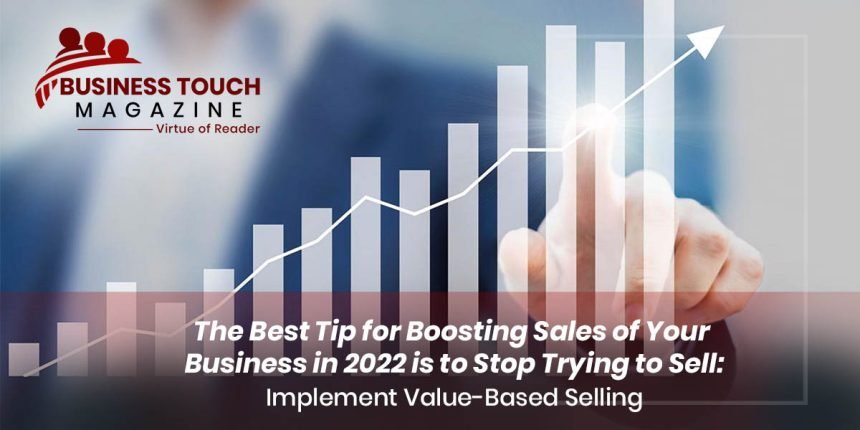Value-Based Selling Is the Act of Prioritizing the Customer’s Needs
Value-based selling is the act of prioritizing the customer’s needs over those of the sales professional. That is a value-based approach to selling refrains from the practice of pushing a solution at every stage of the buying process. Instead, value-based selling seeks to bring meaningful value to customers without directly positioning the solution.
This approach is counterintuitive. Sales professionals have a quota to fulfill. Therefore, a value-based approach in which the customer’s needs come first can appear to slow the momentum of the sale because serving the customer does not always mean advocating for the value of various products and services. However, the long-term benefits are considerable because this style of selling seeks to develop the customer’s trust in the sales professional first then in the solution.
Why Value-Based Selling Essential
- It considers the needs of customers
- It engages customers and fetches you higher profits
- Build a healthy connection between buyer and seller
Principles of Value-Based Selling
The goal with a value-based selling approach is to put the needs of the customer first, guiding them through the sales process to make an informed decision to best suit their needs (ideally, leading to the purchase of your product). This creates anticipation for the positive result having your product will provide in the mind of the customer. Stand out from the competition and create long-term happy customers by providing more value than anyone else.
- Don’t Jump Into Your Sales Pitch Too Early
Resist the temptation to dive into your sales pitch as soon as you get your prospect on the line. Though you might have learned a great deal about their perspective during your research, nothing beats hearing directly from your prospect themselves.
Before convincing them to make the sale with a generic pitch, give them space to explain their current situation and what they are looking for. In addition to helping, you build trust with the prospect, not jumping immediately into your pitch can give you more insight into how you can best provide value to them and can help you position your product better for the sale.
- Eliminate Your Buyers’ Fears
It doesn’t matter how much value you think you have added to your product—if you can’t convince your prospective client that you’ll definitely solve their problem, they aren’t going to click Buy. There are lots of different ways you can eliminate your customers’ fears.
Case studies are an excellent approach to show customer value by demonstrating existing customer successes. Whether they’re in the form of a custom video or a written success story, sharing feedback from companies that already love your product can go a long way to persuade potential buyers.
The important thing to remember for value-selling associates is that you need to address buyers’ fears along each step of the journey. This is especially true if you have a product with different tiers, as there may be different objections at each level or different stages of the sales process.
- Be An Educator, Not A Salesperson
The best examples of a value-selling framework don’t even look like sales pitches. They start off as education, and from there, companies can build trust and brand awareness and become a trusted solution when the customer is ready to spend money to solve their problem. Only then do the sales reps step in to close the deal.
Whether the person using the resources is a customer or not, there is no denying the impact of their value-based sales methodology. Companies provide an enormous amount of free educational content all while building their brand reputation as a trustworthy industry source.
The beauty of this is if you give, give, give to your customer from the very beginning and throughout the sales cycle when you do approach them with an offer, you have already subconsciously earned their trust by demonstrating your expertise.
- Keep A Personable Approach.
As you embark on value-based selling make sure you keep a conversational, personable tone when engaging with your prospects. This shows you have a genuine interest in them and are not merely talking to them to make the sale.
Ask open-ended questions — All of the questions you ask your prospect should be for the sake of genuinely getting to know them, and they should all require answers that require some explanation.
Master the art of small talk — While small talk may be the bane of every introvert’s existence, there’s no denying it can be a powerful tool for building trust with your prospect.
Speak as if you’re talking to a friend — Ultimately, you want the prospect to feel like they are receiving advice from a trusted advisor. Deliver your content the way you would deliver it to a friend to keep it personable and relatable.
- Be Genuine And Trust-Worthy
With value-based selling, there comes a responsibility. You pose as an expert and, in a way, make prospects look up to you for advice on how they can improve their work process.
You have to win their trust, and you have only one chance to do that. If by chance, you disappoint them, you can lose the client. The other person will trust you when you show that you are an expert in your field and live up to it. For that, you have to gather as much information as you can and expand your knowledge about your product or service.
At the same time, be genuine. If you don’t know something, be honest and tell them. It would help build trust and is much better than misleading the prospect.
Conclusion
Value-based selling helps the customer understand that they are not part of a by-the-numbers sales and marketing approach. Instead, the potential customer begins to see the sales rep as an advisor. In the most successful engagements, the sales professional is even seen as an extension of the stakeholder team. Their business acumen and insight are a welcomed part of the process. Value-based sales help to build a client base by delivering more than a solution. With this approach the customer’s needs are understood, the ideas discussed are relevant, and the process is enlightening.




